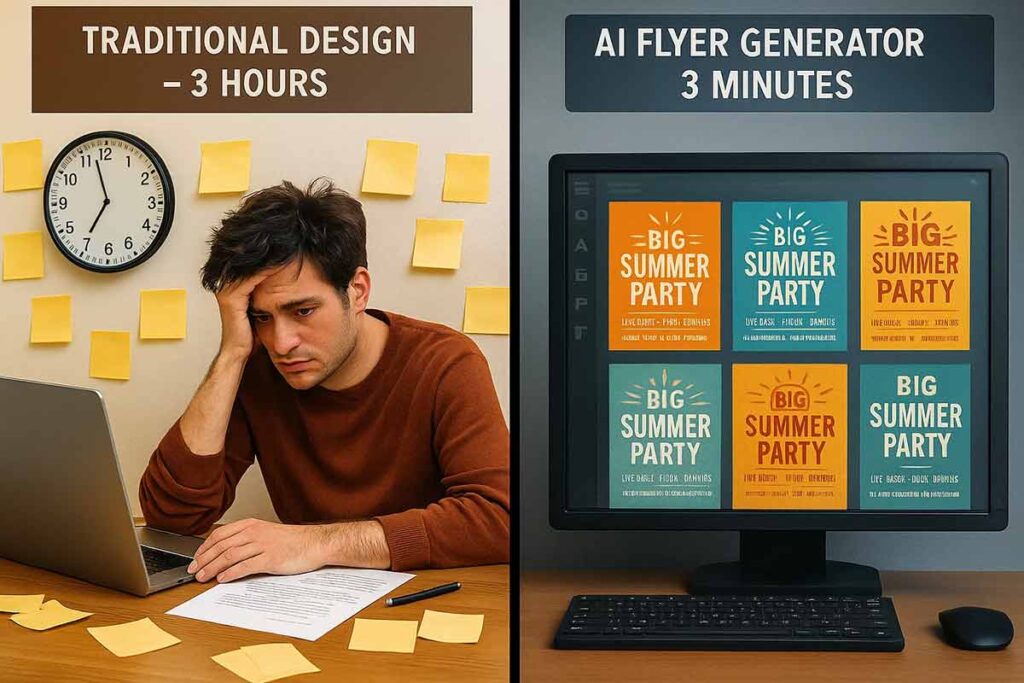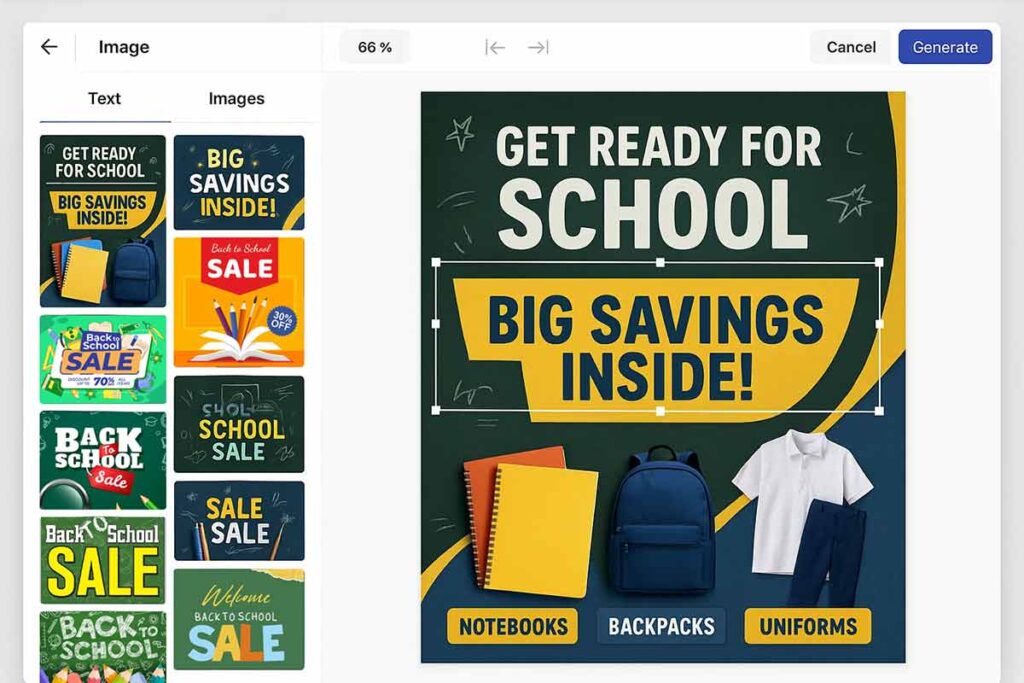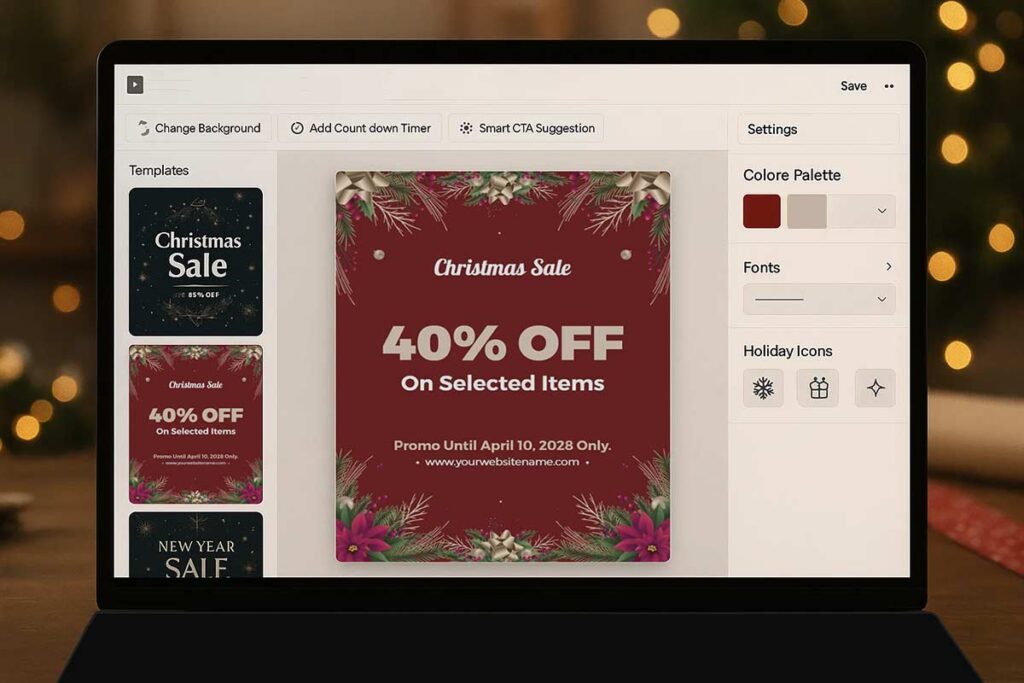An AI flyer generator is reshaping 2026 marketing by helping businesses create personalized, high-impact promotional materials for seasonal campaigns, local events, and targeted outreach. It offers fast, affordable design solutions that meet the growing demand for speed, customization, and visual appeal—making it ideal for small businesses, non-profits, and entrepreneurs.
This guide covers how to use AI flyer generator for holiday promos, spring events, and year-round branding. You’ll learn how to align your flyers with trends like hyper-personalization and sustainable design, while using data-driven insights to boost engagement and ROI—all with scalable templates and instant customization.
Why Is an AI Flyer Generator a Must-Have for 2026 Marketing?
An AI flyer generator becomes essential for 2026 marketing because it enables businesses to create personalized, data-driven promotional materials at unprecedented speed and scale. Companies using AI-powered design tools experience faster campaign deployment and higher engagement compared to traditional methods. This technology addresses the growing demand for hyper-personalized marketing while reducing production costs and time-to-market constraints.
Cost-Efficiency Democratizes Professional Design
Budget constraints often force small businesses to compromise on the quality of their marketing materials. An AI flyer generator helps eliminate this barrier by offering professional-grade design tools at a fraction of traditional costs. Research from the 2026 AI Marketing Trends Report shows that businesses using AI design tools reduce their flyer design expenses by up to 60%, while still maintaining high visual standards.
The benefits go beyond just saving money. Internal productivity improves significantly as marketing teams can design and update flyers on their own—cutting out delays from external approvals or designers. This flexibility supports real-time edits and campaign shifts, allowing businesses to respond faster without straining the budget.
Personalization at Scale Drives Engagement
2026 marketing success depends on delivering relevant, personalized content to specific audience segments. AI flyer generator analyze customer data to customize visual elements, messaging, and offers for different demographics. This personalization extends beyond simple text replacement to include color schemes, imagery selection, and layout optimization based on audience preferences.
The technology enables dynamic content creation that responds to real-time data inputs. Inventory levels, seasonal trends, and customer behavior patterns automatically influence design elements, ensuring marketing materials remain current and compelling. This responsiveness proves particularly valuable for e-commerce businesses and service providers with fluctuating demand patterns. AI is rapidly transforming marketing by enabling real-time personalization, automation, and data-driven decision-making across digital channels (Harvard Division of Continuing Education.1
Speed and Scalability Transform Campaign Execution
Modern marketing demands rapid response to market opportunities. An AI flyer generator processes campaign requirements instantly, generating multiple design variations in minutes rather than hours. Seasonal promotions, flash sales, and trending topic responses require immediate visual content deployment. Traditional design workflows cannot match this velocity.

The scalability advantage becomes crucial for businesses managing multiple locations, product lines, or customer segments. A single AI flyer maker can simultaneously produce localized versions for different markets, maintaining brand consistency while adapting messaging for specific audiences. This capability proves invaluable for franchise operations, retail chains, and service providers operating across diverse geographic regions.
Integration with 2026 Marketing Ecosystem
Modern marketing operates across multiple channels simultaneously. An AI flyer generator integrates seamlessly with CRM systems, email platforms, and social media management tools, creating cohesive omnichannel campaigns. This integration ensures consistent brand messaging while optimizing format specifications for each distribution channel.
The technology supports emerging marketing trends including augmented reality experiences, interactive QR codes, and sustainability-focused messaging. As consumer preferences evolve toward environmental consciousness, AI generator can automatically suggest eco-friendly design elements and digital-first distribution strategies.
Data-Driven Design Optimization
Unlike traditional design approaches, AI flyer generator continuously learn from performance data. The system analyzes engagement rates, conversion metrics, and user feedback to refine future designs. This iterative improvement process ensures marketing materials become more effective over time without additional human intervention.
Performance tracking capabilities enable A/B testing at scale, comparing design variations to identify optimal combinations of colors, layouts, and messaging. This scientific approach to design optimization produces measurably better results than intuition-based traditional methods.
Competitive Advantage Through Innovation
Businesses adopting AI flyer generator gain significant competitive advantages in market responsiveness and creative capability. The technology enables rapid experimentation with design concepts, supporting innovative marketing approaches that differentiate brands in crowded markets.
The AI flyer generator provides comprehensive strategies for implementing AI-powered design systems across various campaigns. Meanwhile, the flyer templates section offers ready-to-use designs that help businesses quickly deploy professional-looking flyers without starting from scratch.
The combination of speed, cost-efficiency, personalization, and data-driven optimization makes an AI flyer generator indispensable for 2026 marketing success. Businesses that embrace this technology will outperform competitors still relying on traditional design methods, capturing market opportunities faster and more effectively than ever before.
Read more: Why Marketers Are Switching to AI Flyer Generator for Promotions
What Are the Top Use Cases for an AI Flyer Generator for 2026?
AI flyer generator transform 2026 marketing by enabling rapid, high-impact promotional materials for seasonal campaigns, personalized marketing, and small business branding. The top use cases include Q4 holiday campaigns, hyper-personalized marketing, small business growth, event promotions, and real-time campaign optimization. These tools deliver professional flyers in minutes while supporting emerging trends like sustainability and multilingual campaigns.
Q1: New Year & Winter Promotions (Jan–Mar)
The first quarter is all about fresh starts, making it a great time for launching New Year sales, winter clearance events, and fitness promotions. Businesses like gyms, wellness centers, and fashion retailers can use this time to re-engage audiences with fresh offers. This season shows strong interest in AI-generated promotional designs.
AI flyer generator make it easier to apply seasonal themes, with readymade templates that reflect winter vibes—think icy blues, snowflakes, and cozy tones. Brands can quickly customize flyers for both print and digital with minimal effort. These templates are especially useful for fashion sales and gym memberships, offering visual variety across platforms.
With multi-format outputs including posters, Instagram stories, and traditional prints, businesses can launch winter campaigns quickly. Whether it’s promoting a January detox or a March winter clearance, AI flyer maker allow faster turnarounds and better design consistency, helping businesses stand out early in the year.
Q2: Spring Promotions and Events (Apr–Jun)
Spring is a season of renewal and color—perfect for running seasonal sales, event flyers, and fresh product launches. Retailers and local businesses can attract attention with vibrant AI-enhanced visuals that capture spring’s energy. From Easter specials to Earth Day awareness events, the opportunities are endless.
AI flyer generator adapt to seasonal trends by suggesting bright palettes, floral elements, and layouts fit for both online and offline audiences. The tools help craft targeted messages whether you’re promoting a local spring fair or a global campaign, ensuring the visuals resonate across regions.
Since spring is packed with short-term events and fast-moving sales, speed is essential. AI tools help teams iterate quickly by offering quick edits, smart layouts, and real-time design options. This ensures your flyers are always fresh, timely, and visually engaging.
Q3: Back-to-School & End-of-Season Sales (Jul–Sep)
The third quarter marks the return to school and the wrap-up of summer sales, making it ideal for retail promotions. Whether you’re selling school supplies, organizing end-of-season clearances, or offering student discounts, this is a key moment for flyer marketing. AI flyer tools help retailers keep pace with seasonal urgency.

AI-assisted layouts make it easier to highlight products like backpacks, stationery, or summer clothing deals. By generating focused designs, the tool keeps the visuals product-centric while ensuring they remain engaging for both students and parents. Calls to action are optimized to drive quick decisions—perfect for time-limited sales.
One-click resizing options allow flyers to be repurposed across print, email, and social media platforms without manual work. From school campaigns to last-minute summer promos, AI flyer maker streamline the entire design process so businesses can meet their targets before fall begins.
Q4: Holiday Campaigns (Oct–Dec)
The holiday season is peak time for promotions—from Black Friday to Christmas and New Year deals. With high consumer engagement, businesses must stand out with eye-catching flyers that capture urgency and festive cheer. AI-generated holiday themes help speed up this process while keeping designs fresh and relevant.

AI flyer generator quickly produce festive layouts with seasonal icons, rich color palettes, and optimized CTAs that drive urgency. These templates are especially helpful for sales that need fast deployment across multiple channels like print ads, social posts, and email blasts.
For busy marketing teams, multi-format outputs ensure that no time is lost creating different versions of the same design. Whether you’re promoting a limited-time Christmas bundle or a last-minute New Year flash sale, AI flyer maker enable consistent branding and fast rollouts for year-end success.
Hyper-Personalized Marketing Campaigns
In today’s marketing landscape, personalization is key. AI flyer maker now enable audience segmentation by analyzing customer behavior to tailor offers accordingly. This ensures your flyers resonate with specific groups based on interests, demographics, or past purchases.
With dynamic content options, the same flyer can appear in different languages, styles, or offers depending on the viewer’s location or preferences. This localized approach makes your campaigns more relevant and engaging, especially for brands with diverse customer bases. AI plays a foundational role in marketing personalization by enabling businesses to deliver tailored content that strengthens consumer engagement and enhances long-term brand loyalty.2
Integrating with CRM systems adds another layer of precision. You can automatically pull in customer data to generate flyers that feel individually crafted—maximizing impact without requiring manual effort.
Small Business Branding and Growth
For startups and SMEs, budget is often a concern—yet branding remains essential. AI flyer maker offer an affordable way to create professional designs that reflect your brand without hiring a designer. AI flyer maker offer an affordable way to create a flyer that reflects your brand without hiring a designer.
Templates for services, products, and seasonal promotions ensure you always have the right visual on hand. From grand openings to weekend specials, small businesses can maintain a polished look throughout their campaigns. You get consistency across your materials, which builds trust with your audience.
As your business grows, these AI tools grow with you. You can scale your flyers for new locations, seasonal changes, or digital vs print formats—all without starting from scratch. That’s key for businesses looking to grow while keeping operations simple.
Community and Non-Profit Engagement
Local events, fundraisers, and awareness drives often have limited resources, making effective design a challenge. AI flyer maker provides accessible tools that allow nonprofits and community groups to create professional flyers quickly and for free. This growing interest reflects the need for cost-effective, high-quality design solutions.
AI-suggested layouts help highlight the mission, call-to-action, or event schedule with minimal design work. Whether it’s a charity walk, donation drive, or cultural festival, you can generate eye-catching visuals without needing prior experience in design.
Quick turnaround is essential for time-sensitive community outreach. AI tools offer editable templates, fast export options, and shareable links—helping your message reach the right people just in time.
Event & Workshop Marketing
Workshops, educational classes, and community meetups need strong promotion to drive attendance. AI flyer maker help by suggesting layouts that suit educational topics, community events, and skill-based sessions—giving organizers a head start.
Custom visuals make each flyer relevant to its topic and audience. Whether it’s a coding bootcamp or a parenting seminar, you can align images, fonts, and colors to fit the tone and attract the right crowd. AI tools offer theme-matching visuals to maintain consistency.
For recurring events, templates can be easily edited and reused, saving time and maintaining familiarity with your audience. You don’t have to rebuild your design from scratch every time—just tweak, update, and publish.
Product Launches & Pop-Up Promotions
When you’re launching a new product or running a one-day promo, speed is everything. AI flyer maker help businesses create high-impact promotional flyers with bold visuals, product highlights, and fast messaging that gets attention.
The AI assists with layout suggestions based on your brand and product type, making each flyer feel tailored and compelling. For pop-ups and launches, the flyers emphasize exclusivity, countdowns, and strong CTAs to drive action quickly.
With support for multiple formats—print, email, and social media—you can roll out your promotions across every channel at once. No need to wait on a designer. Just generate, tweak, and launch.
Real-Time A/B Testing and Performance Feedback
Design doesn’t stop at the first draft. AI flyer maker now support real-time A/B testing by letting users create multiple versions of a flyer—varying the headline, imagery, or call-to-action to see what performs best.
These insights help refine your visuals for better conversions. The tool can suggest tweaks like changing colors, shifting layouts, or testing different fonts based on performance data, turning your flyer into a data-backed marketing asset.
By learning from each campaign, AI flyer tools evolve with your brand. They become smarter at predicting what works, helping marketers create visuals that not only look good—but also drive real results.
Read more: How to Design an Effective Flyer Using AI: A Step-by-Step Guide
Which 2026 Trends Will Enhance the Use of AI Flyer Generator?
Several transformative trends in 2026 will significantly enhance AI flyer generator capabilities, making them more powerful and accessible for businesses. Hyper-personalization, sustainability focus, and immersive technologies will drive adoption. These trends enable businesses to create more targeted, environmentally conscious, and engaging marketing materials that resonate with evolving consumer preferences and technological capabilities.
Hyper-Personalization Through Advanced AI Analytics
The 2026 personalization revolution transforms how AI flyer generator create targeted content. Advanced machine learning algorithms analyze customer behavior, purchase history, and demographic data to generate highly specific flyer designs. This trend allows businesses to create hundreds of personalized variations from a single template, with customized messaging, imagery, and offers for different audience segments.
AI systems now incorporate real-time data feeds, adjusting flyer content based on current market conditions, weather patterns, and local events. This dynamic personalization ensures marketing materials remain relevant and compelling for specific audiences.
Real estate professionals particularly benefit from this trend, as AI flyer generator can automatically adjust property descriptions, pricing displays, and neighborhood highlights based on potential buyer profiles. The technology recognizes patterns in successful listings and applies those insights to new property marketing materials.
Sustainability Integration and Eco-Friendly Design
Environmental consciousness drives significant changes in AI flyer generator functionality for 2026. The technology now prioritizes sustainable design principles, suggesting eco-friendly color schemes, promoting digital distribution over print, and calculating carbon footprints for marketing campaigns.
New features include automatic optimization for digital viewing, reducing the need for physical printing while maintaining visual impact. AI systems recommend recyclable paper types and eco-friendly printing methods when physical flyers are necessary. This trend aligns with consumer preferences for environmentally responsible businesses and helps companies meet sustainability goals.
The sustainability trend extends to template suggestions, where AI flyer generator promote minimalist designs that use fewer resources while maintaining effectiveness. These systems learn from successful eco-friendly campaigns and apply those principles to new designs, creating a positive feedback loop for sustainable marketing practices.
Immersive Technologies and Interactive Elements
Augmented reality (AR) and interactive features revolutionize AI flyer generator capabilities in 2026. These tools create immersive experiences that bridge physical and digital marketing channels. QR codes embedded in flyers now link to AR experiences, allowing customers to visualize products in their own environments or access exclusive digital content.
Interactive elements include embedded videos, clickable product catalogs, and real-time inventory updates. AI systems automatically generate these interactive components based on business type and campaign objectives. Restaurant flyers might include virtual menu tours, while retail flyers offer augmented fitting rooms or product demonstrations.
This trend particularly benefits event planning and party services, where AI flyer generator can create interactive invitations with RSVP tracking, venue virtual tours, and customizable event details. The technology transforms static marketing materials into dynamic, engaging experiences that drive higher conversion rates.
Multilingual and Global Campaign Capabilities
Advanced translation and localization features enhance AI flyer generator accessibility for international markets. The technology now provides accurate translations while maintaining design integrity and cultural sensitivity. AI systems understand regional design preferences, color associations, and cultural nuances that affect marketing effectiveness.
The AI flyer generator automatically adjusts text layouts, font selections, and imagery to accommodate different languages and cultural contexts.
This trend supports businesses expanding into new markets without requiring extensive design resources or cultural expertise. AI flyer generator now include region-specific compliance features, ensuring marketing materials meet local advertising regulations and cultural standards.
Read more: How AI Flyer Generator Handles Accessibility in Typography
Real-Time Performance Optimization
AI flyer generator in 2026 incorporate sophisticated analytics that provide real-time performance feedback and optimization suggestions. These systems track engagement rates, conversion metrics, and user behavior patterns to continuously improve design effectiveness.
Machine learning algorithms analyze successful campaigns across millions of users, identifying design elements that drive results. This collective intelligence helps businesses create more effective marketing materials by leveraging proven strategies from similar industries and target demographics.
The technology now offers A/B testing capabilities within the design process, allowing users to generate multiple variations and receive performance predictions before campaign launch. This predictive analysis helps businesses optimize their marketing spend and improve ROI through data-driven design decisions.
Integration with Emerging Marketing Platforms
The 2026 trend toward platform convergence enhances AI flyer generator functionality through seamless integration with social media, email marketing, and customer relationship management systems. These connections enable automatic campaign deployment across multiple channels while maintaining consistent branding and messaging.
AI systems now understand platform-specific requirements, automatically adjusting dimensions, file formats, and content optimization for different distribution channels. This integration reduces manual work while ensuring marketing materials perform optimally across all platforms.
These technological advances position AI flyer generator as essential tools for businesses navigating the complex marketing landscape of 2026, providing sophisticated capabilities that were previously available only to large enterprises with substantial design resources.
Read more: How AI Flyer Generator Helps to Choose the Right Flyer Elements
How to Implement an AI Flyer Generator for 2026 Success
Implementing an AI flyer generator for 2026 success requires strategic planning, workflow integration, and performance optimization. Start by defining clear campaign objectives that align with quarterly business cycles, then select AI-powered tools that support your marketing goals. Focus on template customization, multi-channel distribution, and analytics tracking to maximize ROI across Q4 holiday campaigns, Q2 promotions, and year-round marketing efforts.

Setting Clear Campaign Objectives
Define specific goals before launching your AI flyer generator implementation. Identify whether you’re targeting Q4 holiday sales, Q2 event promotions, or ongoing brand awareness campaigns. Set measurable outcomes such as lead generation targets, conversion rates, or engagement metrics.
Align your objectives with seasonal marketing cycles to capitalize on peak demand periods. For holiday campaigns, plan Black Friday and Christmas promotions with urgency-driven messaging. For Q2 initiatives, focus on spring sales and community events that drive local engagement.
Consider your target audience segments and their preferred communication channels. Real estate professionals need property marketing materials, while small businesses require promotional flyers for services and products. Tailor your campaign objectives to match specific industry needs and customer behaviors.
Leveraging AI Templates and Customization
Select industry-specific templates that match your campaign objectives and brand identity. AI flyer generator offer pre-designed layouts for real estate, retail, events, and professional services. Choose templates that align with 2026 design trends like minimalist aesthetics, bold typography, and mobile-optimized layouts.
Customize templates using AI-recommended visuals, colors, and messaging. Modern AI tools analyze your content and suggest optimal design elements based on industry best practices and audience preferences. Incorporate your brand colors, logos, and fonts to maintain consistency across all marketing materials.
Adapt designs for multiple formats including print, digital, and social media distribution. AI generator automatically resize content for different platforms while maintaining visual consistency. Test various design combinations to identify the most effective layouts for your target audience.
Integrating with Marketing Workflows
Connect your AI flyer generator with existing marketing platforms for seamless distribution. Integrate with email marketing systems, social media schedulers, and customer relationship management tools. This automation reduces manual work and ensures consistent messaging across all channels.
Set up automated triggers for seasonal campaigns and product launches. Configure your system to generate flyers automatically when new products are added or sales events begin. This proactive approach ensures timely marketing materials without manual intervention.
Create approval workflows for team collaboration and brand compliance. Establish review processes that maintain quality standards while enabling rapid deployment. Use version control to track changes and maintain brand consistency across all marketing materials.
Tracking and Optimizing Performance
Implement comprehensive analytics tracking to measure flyer effectiveness and ROI. Use QR codes, unique landing pages, and promo codes to track offline-to-online conversions. Monitor engagement metrics including click-through rates, conversion rates, and social media shares.
Conduct A/B testing on different design elements, messaging, and distribution channels. Test headline variations, color schemes, and call-to-action buttons to identify optimal combinations. Use data-driven insights to refine your approach and improve campaign performance. Research confirms that AI-powered marketing solutions lead to measurable improvements in campaign efficiency, optimization, and return on investment when compared to traditional methods.3
Analyze seasonal patterns and audience preferences to optimize future campaigns. Track which designs perform best during different time periods and adjust your template selection accordingly. Use this data to predict trends and prepare for upcoming marketing opportunities.
Measuring Success and ROI
Establish key performance indicators that align with your business objectives. Track metrics such as lead generation, sales conversions, brand awareness, and customer acquisition costs. Compare AI-generated flyer performance against traditional design methods to quantify efficiency gains.
Calculate cost savings from reduced design time and improved conversion rates. Factor in the elimination of design agency fees and faster campaign deployment when measuring ROI. Document case studies that demonstrate the business impact of your AI flyer generator implementation.
Monitor long-term brand consistency and customer satisfaction scores. Ensure that AI-generated materials maintain quality standards and reinforce brand identity. Regular performance reviews help identify areas for improvement and optimization opportunities.
By following this systematic implementation approach, businesses can leverage AI flyer generator to create professional marketing materials that drive engagement and conversions throughout 2026’s dynamic marketing landscape.
Read more: How to Get Started with the ChatGPT DesignWiz AI Flyer Maker Plugin
People Also Ask About an AI Flyer Generator for 2026
It offers pre-designed templates and trend-based recommendations for holidays, events, and clearance sales throughout the year.
Retailers, real estate agents, gyms, event organizers, and nonprofits use AI flyers to launch fast, visually engaging campaigns without hiring designers.
Yes, they generate high-impact visuals instantly, ideal for urgent promotions with countdown timers, CTAs, and multiple format options.
Absolutely. They support multiple languages, cultural layouts, and region-specific visuals, expanding reach to diverse audiences.
They use CRM integration and behavioral data to tailor imagery, offers, and messages to each audience group or persona.
Yes, they promote eco-friendly formats, suggest low-ink and digital-first templates, and reduce paper usage by encouraging digital sharing.
Yes, they offer free or low-cost templates tailored for fundraisers, awareness drives, and local events—no design experience needed.
You can design, customize, and export a flyer within minutes thanks to AI-powered automation and smart suggestions.
Yes, they connect with tools like CRM, email platforms, and social media managers for seamless flyer deployment and tracking.
Frequently Asked Questions
Understanding how an AI flyer generator transforms modern marketing requires addressing common questions about implementation, capabilities, and strategic advantages. These frequently asked questions provide insights into maximizing AI-powered flyer creation for diverse business needs.
AI flyer maker automate layout, color, and content choices, saving hours of manual work while adapting designs to marketing trends.
Yes, they support multi-format output for print, social media, email, and digital ads—ensuring brand consistency across platforms.
Absolutely. It’s built for non-designers, offering easy customization, brand storage, and smart visuals without needing technical skills.
Yes, saved templates can be updated for future use, which is especially helpful for weekly deals, monthly events, or franchise campaigns.
Choose a template based on your industry and goal, then customize it with your brand colors, fonts, and logo. Smart suggestions help you stay on-brand with minimal effort.
Not really. While AI handles suggestions, you retain full creative control and can customize layouts, texts, and images anytime.
Compare engagement rates, leads, and sales from AI-designed campaigns versus traditional methods to assess time savings and impact.
Conclusion and Implementation Strategy
Success with an AI flyer generator in 2026 starts with a focused strategy. Identify key use cases such as holiday promotions or seasonal campaigns. Prepare your templates early and customize them quickly to respond to current trends and market needs.
Integrate the flyer maker with existing tools like CRM systems and email platforms to maintain brand consistency and improve campaign delivery. Use A/B testing to fine-tune elements such as headlines, visuals, and calls to action. Track engagement across digital, print, and social media channels to guide improvements.
Keep your designs aligned with 2026 trends including eco-conscious messaging, AR integration, and multilingual support. Set monthly performance reviews to adjust strategies and ensure long-term growth. With the right planning and tools in place, the AI flyer generator becomes an essential part of building fast, flexible, and impactful marketing campaigns.
Reference:
- AI will shape the future of marketing. Harvard Division of Continuing Education.
- The role of AI in marketing personalization: A theoretical exploration of consumer engagement strategies. ResearchGate.
- Impact of artificial intelligence on marketing performance (Doctoral dissertation, Walden University). Walden Dissertations and Doctoral Studies. Rodney Taylor, Walden University.



